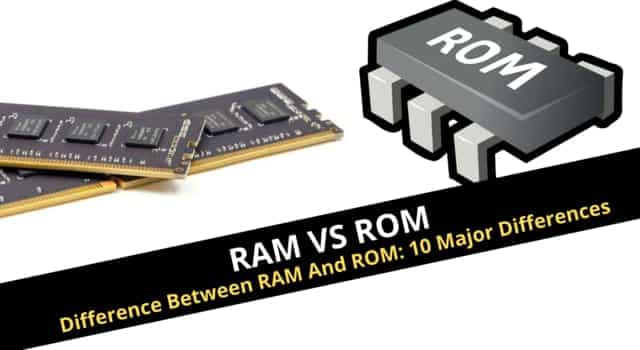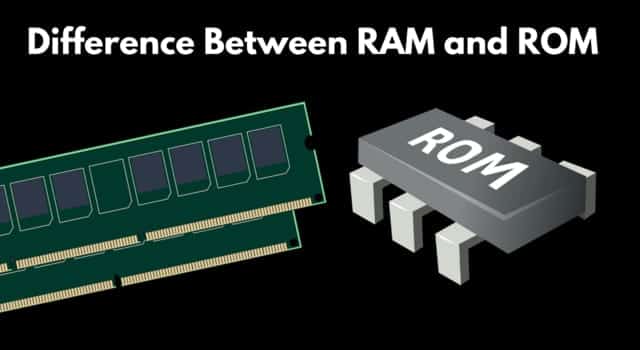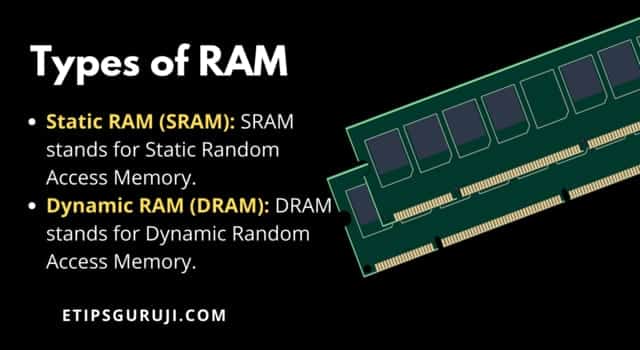Difference Between RAM And ROM: 10 Major Differences

Whether you have a mobile phone or a computer, all of them have RAM and ROM. There are many elements that are common difference between RAM and ROM but there are also some differences between them.
So, in this post, you can get all details related to RAM and ROM, the difference between RAM and ROM, its types along with a general FAQ.
What is the Difference Between RAM and ROM in Computer

There are a total of 10 major difference between RAM and ROM which are listed below:
1. Definition (RAM vs ROM)
RAM stands for Random Access Memory, a form of data storage medium that temporarily store data and instruction on computers and other electronic devices. It is also called direct access memory because it can be accessed randomly at any time, in any order and from any physical location, allowing quick access and manipulation.
Whereas, ROM stands for Read Only Memory, a type of data storage memory that permanently stores data and instruction on computers and other electronic devices.
2. Storage Capabilities
The second main difference between RAM and ROM is the storage capabilities.
RAM is a volatile storage medium, that requires a power supply to store data. In short, contents are lost when the power is turned off or computer crashes.
ROM is known as non-volatile memory, which has the capability to save data even the power is turned off. It means the memory does not depend on an electric current to save data.
3. Working Type
The data on the Random Access Memory can be read, written, and erased any number of times and also can be modified.
The data in ROM memory can only be read, but the user cannot be changed or deleted to the information. In short, data in ROM cannot be modified or can be modified to a limited number of times.
4. Storage Capacity
Another major difference between the RAM and ROM is storage capacity. RAM chips are only used to store data temporarily, it can store multiple GB (gigabytes) of data, often range in storage capacity from 1 to 256 GB per chip.
As a permanent data storage, ROM chips have a storage capacity of only several megabytes (MB) of data, of 4 to 8 MB per chip. However, modern smartphones are coming with higher ROM data capacities.
5. Speed
The accessing speed of RAM is faster. It can boost up the processor speed. While the accessing speed of ROM is slower in comparison with RAM. It cannot assist the processor to boost up the speed.
6. Data Preserving
Electricity is needed in RAM to flow to preserving data. And in ROM, the data can retain or store, if there is no flow of electricity supply.
7. Physical Size
The physical size of the RAM chips is larger than ROM. However, it is available in two primary sizes, for desktop RAM is about 5 ½ inches in length and 1 inch in width and for laptop RAM is about half the length of desktop RAM. Moreover, very small types of RAM are also seen in modern smartphones.
The chip size of ROM is smaller than the RAM, the size of a ROM chip depends on their use. However, it varies from less than an inch in length to multiple inches in length and width.
People Also Read:
- Flash Memory – How it Works, Types, Applications, Advantages
- What is Cable modem- How it Works, Advantages & Disadvantages
- Windows 10 Keyboard Shortcuts – 5 Essential Types
8. Structure
The RAM is a chip, which is usually rectangular in shape and is inserted over the motherboard of the computer. ROMs are generally the optical drivers, which are made of magnetic tape.
9. Cost
The another major difference between RAM and ROM is its pricing. The price of RAM is comparatively high so its much expensive as compared to ROM.
10. Uses
RAM is used in computers to temporarily store files, like a document you’re writing, an image you’re editing, or data for a game you’re playing.
ROM is used for storing a special set of instructions, the BIOS program on a computer motherboard, which the computer needs when it starts up. ROM was used as the storage media in a Nintendo, Gameboy, and Sega Genesis game cartridge.
11. Examples of ROM and RAM
Ram in Computer, Phones, Laptops, Tablets, Gaming machine. Examples of ROM are – Computer BIOS (Basic Input/Output System).
With this our major topic of Difference between RAM and ROM ends. But let’s now looks at the different types of RAM and ROM.
Types of RAM

There are two types of RAM:
Static RAM (SRAM)
SRAM stands for Static Random Access Memory. It is consists of the flip-flop in which the information store in the form of bits.
It requires a constant power supply to retain the data bits. SRAM uses any of 6 transistors for each memory cell. Due to its complex internal circuitry, it has low storage density. SRAM is costlier. It is normally used as cache memory.
Dynamic RAM (DRAM)
DRAM stands for Dynamic Random Access Memory. This type of memory consists of a MOS transistor or capacitor where the information is store in the form of charge.
DRAM uses a single transistor or capacitor for each memory cell. Due to its simple structure, it has a high storage density than SRAM. However, the electrical charge of DRAM decreases with the time that why periodic refreshing is needed to retain the information that result DRAM is slow. It is less expensive and used in Main memory.
Types of ROM

There are three types of ROM:
Programmable Read Only Memory (PROM)
PROM stands for Programmable Read Only Memory. It is developed by Wen Tsing Chow in 1956. This form of ROM is initially blank. However, it is reprogrammable only once time.
So, the user or manufacturer can write data and programs on it only once, using special devices. The chip is one time programmable only, so if there is an error in writing the instructions, the error cannot be removed from PROM and the chip becomes unusable.
Erasable Programmable Read Only Memory (EPROM)
EPROM stands for Erasable Programmable Read Only Memory and inverted by Dov Frohman in 1971. This form of ROM is initially blank. EPROM can be reprogramed using special ultraviolet rays.
If there is an error while writing, the error instruction written can be erased, and then the user can write a new program on it. It means it can still be in used again.
Electrical Erasable Programmable Read Only Memory (EEPROM)
EEPROM stands for Electronically Erasable Programmable Read Only Memory. EEPROM was developed by George Perlegos in 1978. In this type of non-volatile primary memory, the user can erase and reprogrammed with the help of electrical voltages.
In case, if there is an error in writing the data or program, the user can erase and reprogram the contents electronically. By using electric charge the contents of EEPROM can be modified easily.
People Also Read:
- Does My Computer Has Bluetooth or Not? 3 Basic Tips & Guide
- Best Solutions if Your Touchpad Not Working – Windows/ MAC
- What Motherboard do I have? – Step by Step Guide
Advantages and Disadvantages of RAM and ROM
Advantages of RAM
In addition to this, RAM has many advantages.
- Because it boosts the computer’s performance, you may have more RAM because of this.
- RAM is slower than the CPU at reading data. A USB flash drive is a better option than a hard disc or CD/DVD/FLOPPY/DISK.
- Battery life is used extremely sparingly.
- It is capable of both writing and deleting.
Disadvantages of RAM
RAM’s drawbacks include the following:
- When the CPU has to read data from RAM, the registers and cache are much slower to access.
- It’s difficult to keep data in RAM indefinitely since it’s “volatile”.
- It’s much Expensive
- A small amount of room is available.
Advantages of ROM
ROM’s benefits include the following:-
- It doesn’t lose its data and is less expensive than RAM.
- They don’t need to be updated frequently because they are static.
- There are no complicated circuits, and ROM is far more dependable than RAM.
- It’s possible to keep data for eternity.
- Starting the computer and launching the operating system are made easier with its assistance.
Disadvantages of ROM
Some of the ROM’s drawbacks include:-
- The read-only nature of ROM means that it cannot be altered.
- It is impossible to make modifications if they are needed.
General FAQs
Why RAM is faster than ROM?
Simply said, RAM is quicker than ROM because writing data to a ROM chip takes time, but writing data to a RAM chip takes less time. While a RAM chip has the capacity to store many gigabytes (GB) of data, up to 16 GB or more per chip, the same amount of data is often stored on a ROM chip.
Why is ROM important?
ROM is important because of its specific feature i.e. the data store forever and cannot be lost even after power supply switched off, data cannot be changed by any program or user, and it’s cheaper than RAM.
Is ROM the main memory?
ROM is the permanent part of the primary memory or non-volatile memory hence it does not lose its contents when the power supply is turned off or interrupted.
What is RAM and ROM in a phone?
RAM is a volatile memory that is available in 4gb, 6gb, 8gb, 12gb while ROM memory is the device’s internal storage in a phone.
Why is RAM volatile memory?
RAM is a volatile memory because when the system isn’t running or loses power supply, all the data stored in RAM evaporates.
What is faster RAM or ROM?
RAM is faster than ROM because reading data from the RAM is much faster than reading data from the hard drive.
Difference between RAM and Storage Capacity?
It’s easier for a computer to process information when it has a large amount of memory. The more RAM you have, the more apps you can run at the same time. Long-term storage is what we mean by the term “storage.” No matter how much storage space it has, a computer with 1 GB of RAM will run at the same speed.
